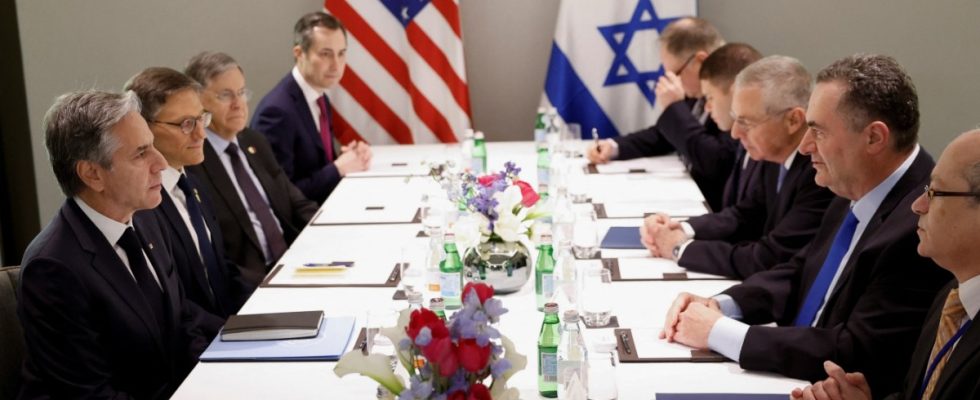He flew in late in the evening, but he can’t take a break on this trip, which is like a long-distance race. A race against time. In Israel, where all the threads come together in the current Middle East conflict, US Secretary of State Antony Blinken wants to pave the way out of the war over Gaza – and at the same time must try to prevent this war from spreading to a second front in Lebanon. This task is certainly worth every effort on a tour with previous stops in Jordan, Turkey, Qatar, the United Arab Emirates and Saudi Arabia. But wherever Blinken sets his sights, he will encounter major hurdles.
“There is a lot to discuss, especially about the way forward,” he said to President Isaac Herzog at the start of his series of talks in Israel on Tuesday. Meetings quickly followed with Prime Minister Benjamin Netanyahu, Defense Minister Joav Gallant, war cabinet member Benny Gantz, secret service representatives and relatives of Israeli hostages. Blinken is in Israel for the fifth time since the war began on October 7th – but this time too he will hardly come any closer to peace.
After three months, fighting in the Gaza Strip is finally expected to subside
What remains for him is to clearly formulate the expectations that Washington has of its closest ally: the fighting in the Gaza Strip should finally subside after three months in order not to further increase the death toll of civilians and humanitarian aid for the 2.2 million to secure residents. President Joe Biden personally underlined this again when he appeared at a church in distant South Carolina on Monday when he was harassed by demonstrators demanding a ceasefire in Gaza. He promised that he would work “quietly” with the Israeli government to significantly reduce its military presence in the Palestinian coastal strip.
Israel responded to US calls for more defense with an unusual media offensive in two American newspapers. Army spokesman Daniel Hagari assured the New York Times, that the war had already entered a new phase “without ceremony”: with fewer troops on the ground and fewer air strikes. Defense Minister Gallant announced in Wall Street Journal a shift from the “intensive maneuver phase to special operations.”
This pretty much reflects what the US government expects. It is questionable, however, whether this corresponds to reality – or whether it is intended primarily for American ears in order not to lose support for a continuation of the war. In any case, bitter fighting was reported from Gaza parallel to Blinken’s visit, with 249 deaths on the Palestinian side within 24 hours. This is the highest number of victims in one day since the beginning of the year. Nine Israeli soldiers also died in action during this time.
In the center and south of the Gaza Strip, the fighting continues unabated
The new phase, which has been accompanied by the dismissal of reservists since the beginning of the year, can only apply to the northern part of the Gaza Strip at most. There, Israel recently announced the dismantling of the Hams’ military structures. In the center and south around Khan Yunis, however, the fighting continues unabated, and some outstanding tasks have not even been started, especially around the city of Rafah on the border with Egypt.
In large parts of the Gaza Strip, an end to the intense war phase is not yet in sight. Israel’s army may be able to point to operational successes with daily reports. But strategically, the first goal of the war, the destruction of Hamas, is far from being achieved. And the second goal of the war, the liberation of the still around 130 hostages, is becoming increasingly distant.
In all of this, to the displeasure of the USA, Israel continues to follow the policy of avoiding concrete debates about the day after. Defense Minister Gallant ruled out a “civilian Israeli presence” in the Gaza Strip last week. But there are loud voices in our own government that demand the opposite. Blinken is likely to continue to hit granite with his demand to make a two-state solution the basis of the post-war order.
The great danger is that the war could “metastasize”.
At the beginning of his trip, Blinken drastically formulated the danger, which extends far beyond Gaza: the war could “metastasize.” The fact that the US government does not only blame Hezbollah from Lebanon, which has been provoking Israel with constant shelling since October 8th, is demonstrated by an obviously targeted indiscretion: The Washington Post reports that fears are growing within the American government that Netanyahu could escalate the conflict on Israel’s northern border to ensure his own political survival.
The day before the meeting with Blinken, Netanyahu visited troops in the north, where he sent urgent warnings to Hezbollah. Even clearer was the message from an armed drone that killed a high-ranking Hezbollah commander 15 kilometers from the border on the same day. Two more targeted Israeli attacks were reported in Lebanon on Tuesday, killing at least four Hezbollah members.
All of this shows Blinken how difficult it is to control the ever-increasing flames. From his station in Riyadh, he brought the message for Israel that Saudi Arabia continues to have a “clear interest” in normalizing relations. That could be a tempting vision for peace. But what is more necessary at the moment is a concrete prospect of an end to the war.

